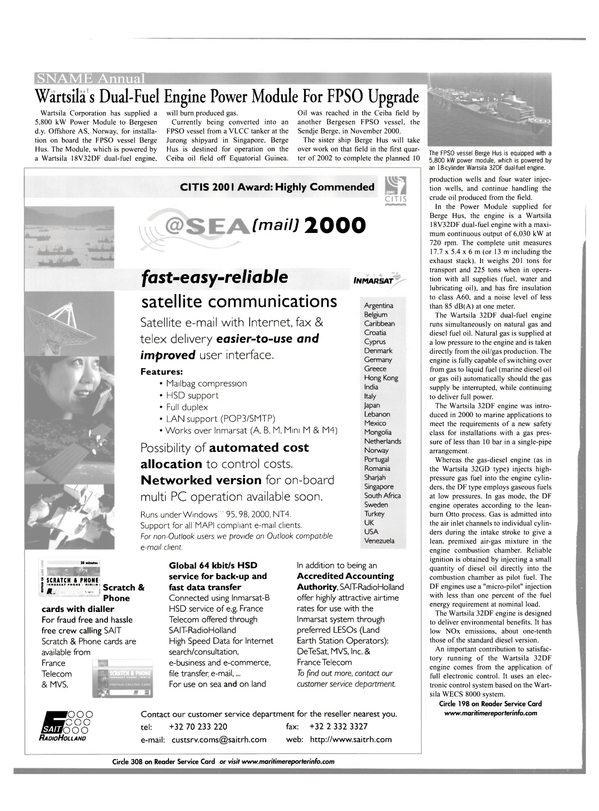
Wartsila s Dual-Fuel Engine Power Module For FPSO Upgrade
Wartsila Corporation has supplied a 5,800 kW Power Module to Bergesen d.y. Offshore AS, Norway, for installation on board the FPSO vessel Berge Hus. The Module, which is powered by a Wartsila 18V32DF dual-fuel engine, will burn produced gas.
Currently being converted into an FPSO vessel from a VLCC tanker at the Jurong shipyard in Singapore, Berge Flus is destined for operation on the Ceiba oil field off Equatorial Guinea.
Oil was reached in the Ceiba field by another Bergesen FPSO vessel, the Sendje Berge. in November 2000.
The sister ship Berge Hus will take over work on that field in the first quarter of 2002 to complete the planned 10 production wells and four water injection wells, and continue handling the crude oil produced from the field.
In the Power Module supplied for Berge Hus, the engine is a Wartsila 18V32DF dual-fuel engine with a maximum continuous output of 6,030 kW at 720 rpm. The complete unit measures 17.7 x 5.4 x 6 m (or 13 m including the exhaust stack). It weighs 201 tons for transport and 225 tons when in operation with all supplies (fuel, water and lubricating oil), and has fire insulation to class A60, and a noise level of less than 85 dB(A) at one meter.
The Wartsila 32DF dual-fuel engine runs simultaneously on natural gas and diesel fuel oil. Natural gas is supplied at a low pressure to the engine and is taken directly from the oil/gas production. The engine is fully capable of switching over from gas to liquid fuel (marine diesel oil or gas oil) automatically should the gas supply be interrupted, while continuing to deliver full power.
The Wartsila 32DF engine was introduced in 2000 to marine applications to meet the requirements of a new safety class for installations with a gas pressure of less than 10 bar in a single-pipe arrangement.
Whereas the gas-diesel engine (as in the Wartsila 32GD type) injects highpressure gas fuel into the engine cylinders, the DF type employs gaseous fuels at low pressures. In gas mode, the DF engine operates according to the leanburn Otto process. Gas is admitted into the air inlet channels to individual cylinders during the intake stroke to give a lean, premixed air-gas mixture in the engine combustion chamber. Reliable ignition is obtained by injecting a small quantity of diesel oil directly into the combustion chamber as pilot fuel. The DF engines use a "micro-pilot" injection with less than one percent of the fuel energy requirement at nominal load.
The Wartsila 32DF engine is designed to deliver environmental benefits. It has low NOx emissions, about one-tenth those of the standard diesel version.
An important contribution to satisfactory running of the Wartsila 32DF engine comes from the application of full electronic control. It uses an electronic control system based on the Wartsila WECS 8000 system.
Circle 198 on Reader Service Card www. maritimereporterinfo. com
Read Wartsila s Dual-Fuel Engine Power Module For FPSO Upgrade in Pdf, Flash or Html5 edition of October 2001 Maritime Reporter
Other stories from October 2001 issue
Content
- Gratingless Air Circ System in Reefer Ships page: 44A
- New Technology To Debut At Europort page: 44B
- AIS: T h e Future is N ow page: 44F
- NOL Reports First Half Profit of $1M page: 4
- Speechless page: 6
- John Deere Offers N ew 3 0 0 HP Engine page: 7
- Now the Carousel Ship page: 8
- Port Security Strengthened in Wake of Disaster page: 12
- A Race With A Meaning ... Before the Fall of the Towers page: 14
- SCI: Disaster Relief on the Fly page: 15
- Following Wake of Terrorist Attacks, USS Cole is Relaunched page: 18
- INTERTANKO Offers Support, Vital Information During National Tragedy page: 19
- G O M Softness Drives GLM Score Down page: 20
- All-Purpose Aid And Hospital Vessel Delivered page: 21
- ASRY's Services Are In High Demand page: 23
- Rolf To The Rescue: German Yard Delivers Aluminum Rescue Launch page: 25
- Fusion Polycraft's RIB Designed To Be Indestructible page: 25
- Sea-Kindly: A Steady Vessel by Design page: 26
- New Inland Containership Concept Unveiled page: 30
- High-Tech Service Initiatives From Deltamarin page: 32
- FORAN v50: A Technological Renovation page: 36
- N a p a O y Opens Office In Japan page: 38
- NUPAS-Cadmatic Offers V4.3 page: 40
- Ship Evac Simulation Software Shows Promise page: 42
- Wartsila s Dual-Fuel Engine Power Module For FPSO Upgrade page: 44
- Euroferrys' Fast Ferry Features Cat 3618 Power page: 46
- PRI Fuel Treatment Helps Meet Emissions Challeng es page: 47
- Western Towboat Gets A N e w Titan page: 48
- Nichols Bros. To Construct Powerful Fireboat page: 50
- Statoil Ships Run on Gas... Liquefied Natural Gas That Is page: 51
- W Q I S Broadens Coverage To Meet State Requirements page: 52
- Wartsila Wins Environmental Award page: 53
- Pumping Ballast for Ocean-Going Barges page: 54
- Self-Cleaning Filter System Cuts Maintenance Costs page: 60
- CMP Packs Decade of Tin-Free Experience page: 62
- MarineLine Boosts C l e a r w a t e r ' s Profitability page: 64
- Dampney Manufactures Advanced Coatings page: 67
- W a r t s i l a Engines To Power Queen M a r y 2 page: 70
- Keppel Hitachi Zosen Delivers Semi-tender Rig page: 73


